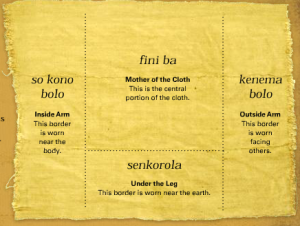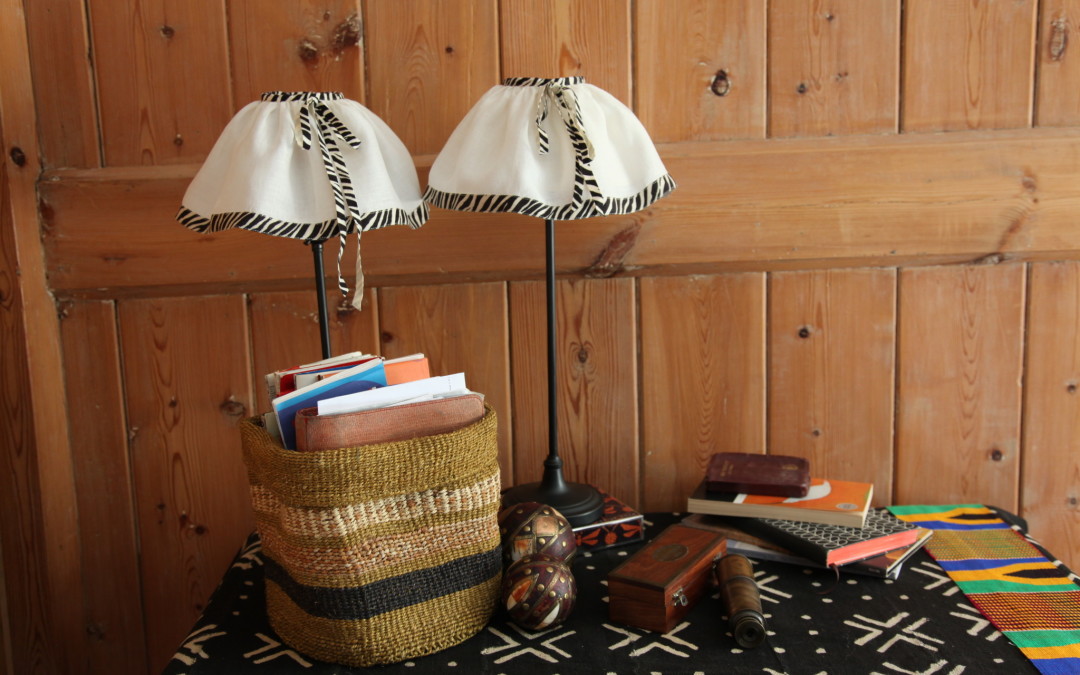What we know as mud cloths are more correctly called Bogolanfini, or Bogolan – loosely translated as ‘by means of mud’. The mud in question is in effect a clay slip with a naturally high iron content that has been fermented for about twelve months. It dyes fabric black, or at least very dark brown. The mud colour changes over time, towards russet ( red ore ) in degrees according to the batch of mud used, the amount of wear, exposure to light, etc. The dyer might also prepare the cloth with different layerings of the mud in order to create varying depths and tones. So we can find them in black and in every shade of earth colour from yellow ochre, through to reddish browns and finally black. These cloths have played and still do play an important part in Malian culture – worn by men for hunting, and by women both at their initiation into adulthood and after giving birth.
Mud cloths start with strips of hand woven linen or cotton that are stitched together to make the size required – usually approx. 1- 1.2 m ( 3/6″ – 4′ ) x 1.5- 1.7 m ( 4’6″ – 5″ or so). Today these strips may well be bought ready – woven at the local market, but in the past they were always made at home, or cetainly within the same neighbourhood. They are always woven by the men and dyed by the women; the strips are narrow because they would have been woven on narrow, backstrap – easily transportable – looms.
Once the cloth is joined it is soaked in water, that has been infused with one of a number of indigenous leaves such as Cengura or Lannea. This acts as mordent, allows the cloth to receive the dye and also has the effect of yellowing the cloth; turmeric and pomegranate are used for the same purpose in other cultures. The cloth is laid out in the sunlight to dry, before the pattern is mapped out onto it.
 The designs for the cloth are traditional and specific, symbolic, and have specific meaning for tribes, events and customs, but to some degree they can be re-worked and changed around to suit the wearer, bearing in mind the sections that will be most seen as it’s worn. The designs are uniquely created by what is left unpainted – so the mud which darkens to brown or black becomes, effectively, the background colour. The mud is left to dry whilst the colour is absorbed by the cloth. Once dry it is rinsed clean. For a deeper colour the process is repeated. The final touch is to bleach the pattern so that it stands out more clearly against the mud, and caustic soda is used for this. The bleach and the black mud are traditionally applied by sticks, or metal rods, which, along with the weave and the mud itself, gives the colour it’s characteristic unevenness.
The designs for the cloth are traditional and specific, symbolic, and have specific meaning for tribes, events and customs, but to some degree they can be re-worked and changed around to suit the wearer, bearing in mind the sections that will be most seen as it’s worn. The designs are uniquely created by what is left unpainted – so the mud which darkens to brown or black becomes, effectively, the background colour. The mud is left to dry whilst the colour is absorbed by the cloth. Once dry it is rinsed clean. For a deeper colour the process is repeated. The final touch is to bleach the pattern so that it stands out more clearly against the mud, and caustic soda is used for this. The bleach and the black mud are traditionally applied by sticks, or metal rods, which, along with the weave and the mud itself, gives the colour it’s characteristic unevenness.
The processes involved mean that Mud cloths take 2 -3 weeks to make.
The Smithsonian Institute have a brilliant interactive programme ( image only below ) which allows you how to make your own ( virtual) Bogolanfini mud cloth on www.mnh.si.edu/africanvoices/mudcloth/index_flash.html.

- the above image of the pattern areas was taken from this programme. You don’t have a cloth you can use of course, and everything is easy until you actually do it – but a great way to learn about things !!

Here is one that is on display at the british museum ref: EAF7778.
We bought ours from: www.africanfabric.co.uk, who buy directly from the source and always have a good selection of interesting designs in stock.

